GERMANS LAUNCH OPERATION CITADEL
Near Kursk, Russia • July 5, 1943
The pivotal year of the war in Europe was 1943. Early February saw Gen. Friedrich Paulus’ German Sixth Army, the largest army the Wehrmacht (armed forces) fielded in the war, surrender at Stalingrad (modern-day Volgograd) in Southern Russia. Some 850,000 service members from German, Italian, Romanian, Hungarian, and Croatian armies were wounded, killed, or captured; 100,000 survivors entered Soviet captivity where most died.
Several months later, in April 1943, the German high command began planning its main summer offensive, Operation Citadel (Unternehmen Zitadelle). Citadel’s aim was to envelop and destroy Soviet forces in the Kursk salient, a bulge measuring 120–160 miles/193–257 kilometers from north to south and a depth of up to 90 miles/145 kilometers (see map below), which both sides saw as a likely springboard for the Soviets’ reconquest of Nazi-held Ukraine, which lay to the east and south. By eliminating the salient, the Germans would straighten their lines of defense on the Eastern Front, nullify Soviet numerical superiority in crucial sectors, and reignite offensive strategic operations halted at Stalingrad.
Soviet intelligence was wise to Operation Citadel. Rather than attempt a preemptive strike, the Soviet high command saw an opportunity to lure the Germans into the horseshoe, wait for their attack to exhaust itself in the face of stout resistance, then crush the enemy with counterblows of overwhelming strength. Indeed, the military balance on Germany’s Eastern Front was all in the Soviets’ favor, though ratio estimates between the belligerents vary among historians: the Red Army had well over a 2‑to‑1 advantage in men, nearly a 7‑to‑1 advantage in armored vehicles, and a 5‑to‑1 advantage in guns and mortars. The Battle of Kursk, which began on this date, July 5, 1943, nonetheless turned into a stunning knock-down, drag-out fight.
Little happened as either side had planned. In the single-most significant fighting, namely, the Battle of Prokhorovka fought on July 12–13, 294 German tanks of the II SS Panzer Corps engaged nearly 3 times that number fielded by the Soviet 5th Guards Tank Army. It was one of the largest tank battles in military history, with the Soviets losing two-thirds of their tanks to the loss of the Germans’ 43. Soviet tanks losses mattered little anymore. In July and August 1943, Soviet factories churned out 4,000 tanks out of the 13,000 produced that year, which were more than sufficient to replace the 1,600 or so lost during the entire Kursk operation.
Adolf Hitler called off Operation Citadel on July 13. Citadel, it turned out, was the last major German offensive on the Eastern Front. Allied landings in Sicily, Italy (Operation Husky), 3 days earlier forced Hitler to move troops and equipment to the Mediterranean Theater to prop up his Axis partner, Benito Mussolini, whose grip on power appeared precarious at best. In the meantime, the Soviets launched their own summer offensive, never to let up until they stood in the rubble of the dead tyrant’s capital in April 1945.
Battle of Kursk, July 5–16, 1943: Death Bell Tolls for Third Reich
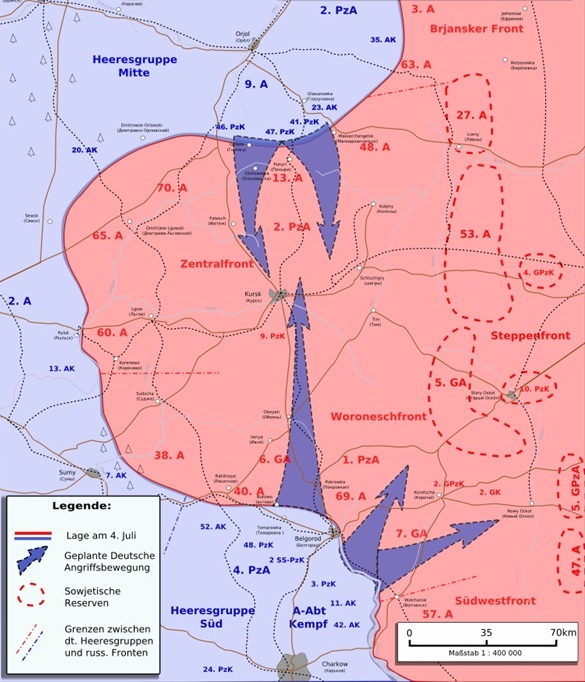 |
Above: Kursk salient (bulge) frontlines and the German plan, Operation Citadel, to eliminate the bulge, July 4–17, 1943. The Russian city of Kursk, a transportation node 280 miles/451 kilometers southwest of Moscow, lies immediately to the left of the blue up and down arrows (Zentralfront on the map). The bulge sucked in huge numbers of opposing men and armor. Initial German combat strength stood at 518,271 soldiers, 7,417 artillery pieces and mortars, and 2,465 tanks spread over a fighting front more than 300 miles/483 kilometers in length. Soviet defenses included 1,426,352 soldiers, 31,415 artillery pieces and mortars, and 4,938 tanks. In addition there were 2,400 antitank and 2,700 antipersonnel mines per active-mile/1.6 kilometer front. Behind Soviet lines were half again as many men and pieces of equipment. The Germans had nothing like that in reserves.
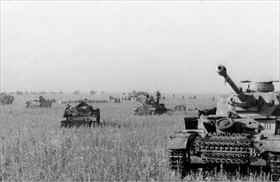 | 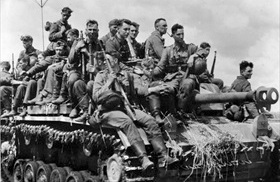 |
Left: German Tiger IIIs and IVs on the move near Belgorod directly to the south and outside the Kursk salient, June 21, 1943. Their aim: penetrate and eliminate the Kursk salient.
![]()
Right: German tanks and men of the “Grossdeutschland Division” take up positions as part of the Fourth Panzer Army in the Kursk salient in early July 1943. The Grossdeutschland was considered to be the premier combat unit of the German Army, receiving equipment before almost all other units. The new Panthers model D that the division received on the eve of the Battle of Kursk were plagued by technical problems, suffering from engine fires and mechanical breakdowns, with many becoming disabled before reaching the battlefield.
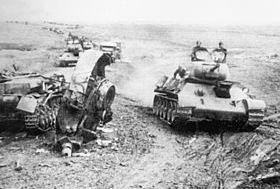 | 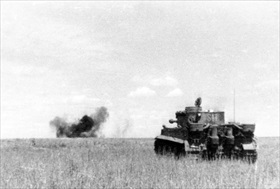 |
Left: Soviet armor advances to engage the enemy. The Red Army fielded Soviet-built T‑34 and U.S.-supplied M3 Lee medium tanks at Kursk. The Soviets managed to produce a total of 84,000 T‑34 medium tanks. This meant that as tens of thousands of them were lost against the Germans, they would actually be replaced in even greater numbers than before, thus winning the battle of attrition over the Wehrmacht’s massively expensive and over-engineered tanks. Extensively upgraded year after year, T‑34s were one of a handful of military vehicles to see continuous production and use throughout the Soviet involvement in what they called the Great Patriotic War, right up to climactic Battle of Berlin, April 16 to May 2, 1945.
![]()
Right: A Waffen-SS Tiger I heavy tank scores a direct hit on a T‑34 tank during the Battle of Kursk, July 10, 1943. The quality of advanced optical sights on the Tiger I and the high velocity 88 mm gun it mounted allowed it to devastate targets at long range with great accuracy. The German Army Weapons Agency provided information to turret gunners on the best locations for disabling and destroying Soviet armor.
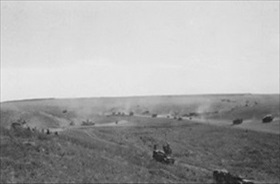 | 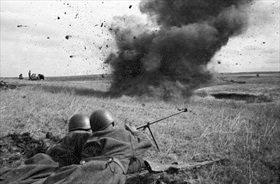 |
Left: Vehicles of II SS Panzer Corps advance toward Prokhorovka, July 11, 1943. The tank battle at Prokhorovka, part of the Battle of Kursk, was a German tactical victory; for the Soviets, it could be seen as either an operational stalemate or an operational victory. In any event, after Kursk the Soviets gained territory along a 1,200‑mile/1,931‑kilometer-wide front.
![]()
Right: Soviet antitank riflemen take aim at an enemy tank after the Battle of Kursk had wound down, July 20, 1943. The Battle of Kursk was the first battle in which a Blitzkrieg (“lightning war”) offensive had been defeated before it could break through enemy defenses and into its strategic depths.
Tank Battle of Prokhorovka, July 12–13, 1943
![]()

 History buffs, there is good news! The Daily Chronicles of World War II is now available as an ebook for $4.99 on Amazon.com. Containing a year’s worth of dated entries from this website, the ebook brings the story of this tumultuous era to life in a compelling, authoritative, and succinct manner. Featuring inventive navigation aids, the ebook enables readers to instantly move forward or backward by month and date to different dated entries. Simple and elegant! Click
History buffs, there is good news! The Daily Chronicles of World War II is now available as an ebook for $4.99 on Amazon.com. Containing a year’s worth of dated entries from this website, the ebook brings the story of this tumultuous era to life in a compelling, authoritative, and succinct manner. Featuring inventive navigation aids, the ebook enables readers to instantly move forward or backward by month and date to different dated entries. Simple and elegant! Click 











